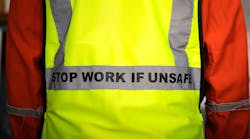The world is not a very safe place to live in right now. You certainly don’t need me to point out that obvious-ism, but from all indications, the “unsafeness” of it all has reached a new heightened threat level, all the more insidious because some of the threats are emerging fully formed from what seemingly had been dormant cocoons. We can stare at something so long that we no longer “see” it anymore, even though the threat is very real.
You can see a ladder lying horizontally in the back of a warehouse. It’s been there for weeks… maybe months. Maybe a year, hard to say. Somebody put it there, some time ago, because it needed some repairs. One of the rungs, maybe, was cracked… something like that. Maintenance was going to fix it, or else order a new one. But nobody told the new hire that the ladder was out of commission, and now she’s going to be out of work for a while with a busted ankle and a couple cracked ribs. The threat from that ladder was very real, to those who recognized the danger, but nobody thought to act on it.
What about that worker that nobody ever talks to at lunch, but everybody seems to talk about him when he’s not around? He made a few weird comments one day, the kind that cause people’s eyes to dilate and their mouths to drop open and wonder, “Did he really say that? There’s something wrong with that guy!” Word is he was in the middle of some messy domestic stuff, but as long as he got his work done, no need to get HR involved, right?
What about that war that broke out overseas? The politicians and the talking heads on TV and radio get their voters and audiences fired up to choose sides on the debate as to which side are heroes and which side are villains. Your employees start looking at each other differently as they realize they don’t all share the same opinion as to who’s right, who’s wrong. Rather than taking a stand to protect all of your employees from contentious rancor, your senior leadership chooses to say nothing at all. And yesterday, one of your own employees got beat up outside of work because his ethnic heritage comes from the “wrong” side of the debate.
There are clear consequences to turning a blind eye to unsafe situations, whether the situations are broken equipment or broken spirits or an irrational belief that things will get better if you just wish them away. The year 2023 will be known for many things, and a lot of them aren’t good things: wars, atrocities, natural as well as human-made disasters exacerbated by negligence, corporate collapses brought on by greed and chicanery, and far too many serious injuries and fatalities in the workplace that could have been prevented.
OSHA was founded more than a half-century ago, and many significant improvements have been made in various areas of workplace safety and the technology to keep people safe is more advanced than ever. And yet, the number of workplace injuries in recent years have been increasing rather than declining. Non-fatal injuries were up 6.3% year-over-year in 2021, and then rose another 4.5% in 2022, according to the Bureau of Labor Statistics. In real numbers, there were 2.3 million injuries on the job last year. So while the total number of injuries has declined significantly over the past 50 years, we’re left to wonder why so many workers are still getting hurt.
The answer, of course, is that even the best safety leaders can only do so much. At our recent Safety Leadership Conference in Orlando, attendees heard (from multiple sources) that the two hardest things a safety manager has to do (not necessarily in this order) are:
1) Convince employees about the importance of workplace safety. Nobody ever really thinks something bad is going to happen to them.
2) Convince senior management about the importance of workplace safety. For too many senior managers, safety is a cost, not an investment.
All the evidence points to the conclusion that the best-run companies, the most profitable companies, the most attractive companies to investors and prospective employees, are those that do the most to protect their workers and their communities. Companies that set out to establish a culture of safety excellence are those that ultimately succeed. But getting to that point takes a special talent—an inner vision—and special people, the safety leaders who come to work with their eyes wide open, insistent that “nobody is going to get hurt on the job today. Not on my watch.”

